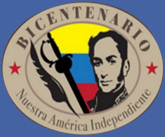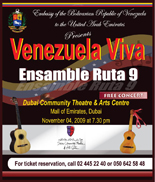
Bolivarian Republic of Venezuela
Embassy in the UAE
Population and Social Patterns Location On the northern coast of South America between latitudes 0 45' and 12 12', and longitudes 59 45' and 73 09' Population is estimated at approximately 20 million, with a birth rate of 29.9 per thousand and a low mortality rate of 4.7 per thousand. In spite of its growth, there is still a low population density. With only 9 inhabitants per square kilometer, Venezuela is one of the least densely populated countries in the Western Hemisphere. The population is very young: about 70 percent is under the age of 40. The urban population is about 80 percent of the total, but is unevenly distributed throughout the country. The Federal District and the State of Miranda, which are the areas with the greatest commercial and financial activity, have a population of 6.9 million inhabitants. The States of Aragua, Carabobo and Lara are industrial and agricultural centers with a total of approximately 4 million inhabitants. Zulia, the major cattle raising and oil producing state, has a population of over 2 million inhabitants. Guayana, the region with the most important mineral reserves and also the large territory of the State of Bolívar, has a population of a little more than 800,000 inhabitants. Venezuela's people result from the mingling of European, Amerindian, and African cultures. Traditionally a haven for people of all origins, Venezuela received large waves of immigrants from Europe following World War II and from other Latin American and Caribbean nations during the 1970s. Education Education in Venezuela is free, universal and compulsory. Approximately 2O% of the national budget is assigned to education, one of the highest percentages in the world. The literacy rate is 89.5%. Through the Ministry of Education, the Venezuelan government provides education at all levels. There are nine years of elementary school, two to three years of secondary school, and three to five years of university or technological studies. |








